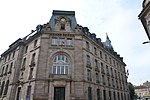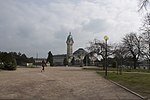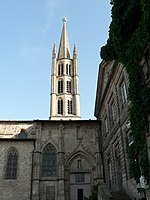Siege of Limoges
1370 in England1370s in FranceConflicts in 1370Edward the Black PrinceHundred Years' War, 1369–1389 ... and 5 more
LimogesMassacres committed by EnglandSieges involving EnglandSieges involving FranceSieges of the Hundred Years' War

The town of Limoges had been under English control but in August 1370 it surrendered to the French, opening its gates to the Duke of Berry. The siege of Limoges was laid by the English army led by Edward the Black Prince in the second week in September. On 19 September, the town was taken by storm, followed by much destruction and the deaths of numerous civilians. The sack effectively ended the Limoges enamel industry, which had been famous across Europe, for around a century.
Excerpt from the Wikipedia article Siege of Limoges (License: CC BY-SA 3.0, Authors, Images).Siege of Limoges
Cours Gay-Lussac, Limoges Le Grand-Treuil
Geographical coordinates (GPS) Address Nearby Places Show on map
Geographical coordinates (GPS)
| Latitude | Longitude |
|---|---|
| N 45.8353 ° | E 1.2625 ° |
Address
Cours Gay-Lussac
87000 Limoges, Le Grand-Treuil
Nouvelle-Aquitaine, France
Open on Google Maps










